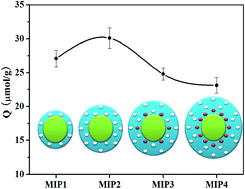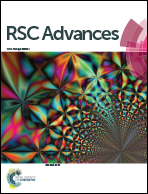Uniform core–shell molecularly imprinted polymers: a correlation study between shell thickness and binding capacity†
Abstract
Core–shell molecularly imprinted polymers (CS-MIPs) have aroused increasing interest owing to their easy accessibility and favorable mass transfer. Herein, we explore the correlation between shell thickness and binding capacity by using Sudan I as template molecule to prepare different CS-MIPs at the surface of carboxyl polystyrene through emulsion polymerization with a two-step temperature-rising process. Extensive characterization was performed using techniques such as SEM/TEM, FT-IR, BET, and TGA. Main factors were systematically studied such as the amount of prepolymer solution, the amount of SDS, and the temperature step. Under the optimized conditions, CS-MIPs with a shell thickness of 2.60 μm presented the highest binding capacity of 30.1 μmol g−1 and the most rapid mass transfer rate. A uniform sphere model was constructed, and it was found that template molecules located in the spherical MIPs with a diameter of 5.20 μm will be completely eluted, thereby attaining the maximum binding capacity. The static adsorption isotherm followed the Langmuir–Freundlich adsorption model, and the fast kinetics obeyed the pseudo-second-order kinetics model. High recognition specificity for Sudan I with respect to its analogues was displayed, with an imprinting factor of 2.7. The establishment of a critical value of shell thickness provides new insights into the preparation methodology and molecular recognition mechanism of core–shell imprinted polymers.


 Please wait while we load your content...
Please wait while we load your content...